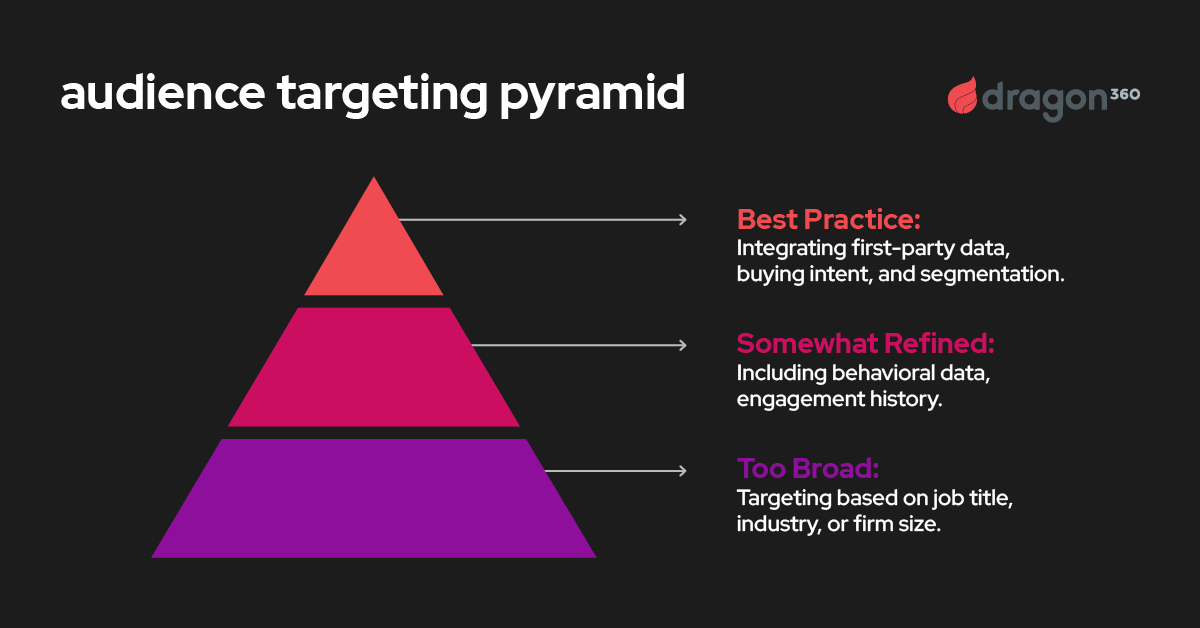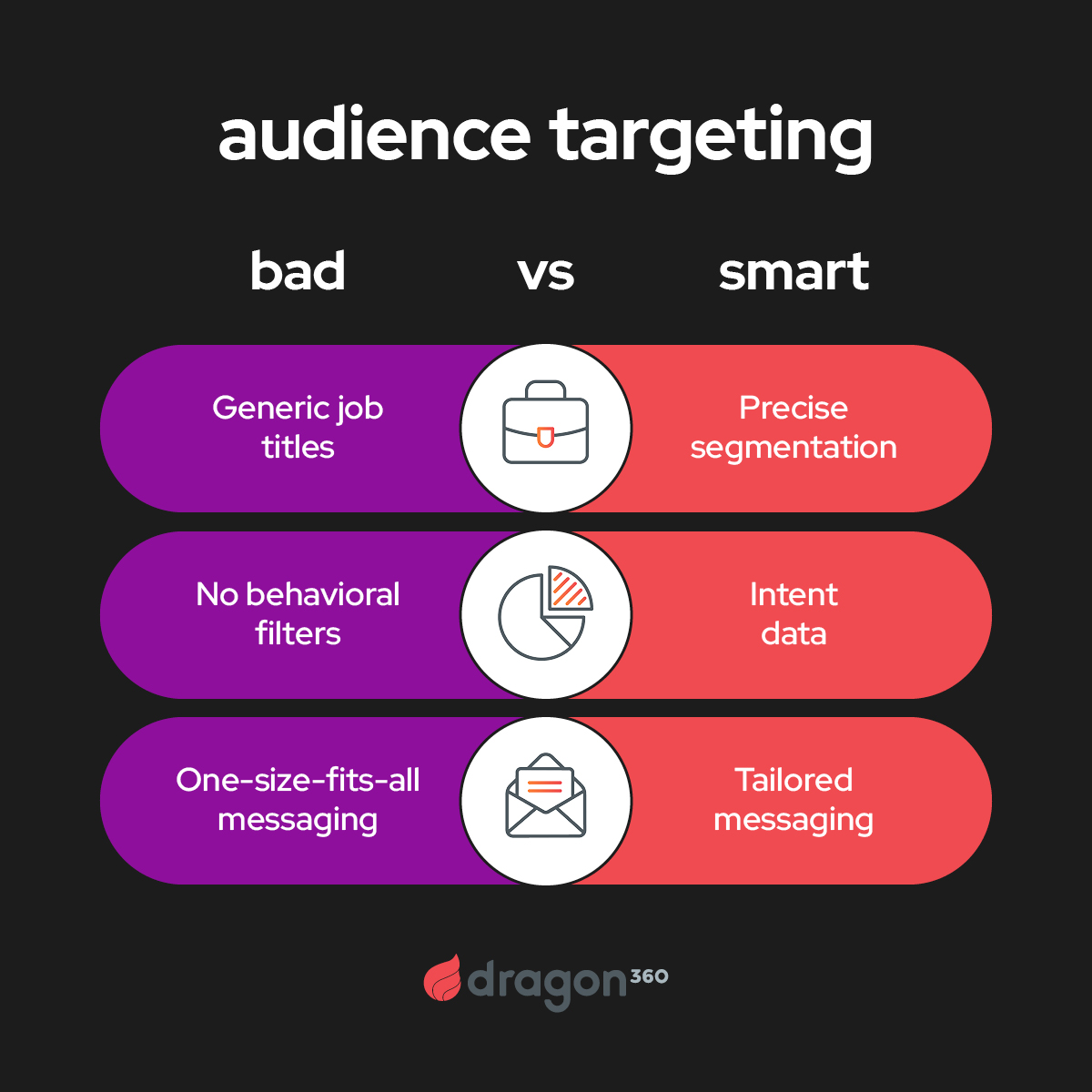Stop Winging It -
Get The Complete B2B Paid Media Guide
Learn how to develop creative that converts and strategy that scales.

Marketers often blame weak creative, lackluster copy, or insufficient budget when ad performance is poor. But none of those issues matter if the right people never see the ad in the first place. Bad audience targeting is the single biggest reason why paid media underperforms.
Many B2B brands waste budget chasing impressions and clicks that never turn into pipeline. More spend won’t fix bad targeting. Refining how and who you target is what truly moves the needle.
This issue persists because audience targeting is often treated as an afterthought in paid media strategy. Too much focus is placed on ad creatives, campaign optimizations, and platform algorithms, while the most fundamental question – who should see these ads in the first place? – is ignored or answered based on outdated assumptions.
B2B buying behavior has evolved dramatically in the past decade. Decision-making is no longer confined to a single executive signing off on a purchase. Instead, it involves multiple stakeholders, champions who drive internal discussions, and self-educated buyers who expect relevant messaging before they even engage with sales. If your targeting doesn’t reflect this complexity, your ads will fail, no matter how well they are executed.
Flawed audience definitions set campaigns up for failure before they even launch. Marketers tend to make the same mistakes repeatedly, leading to inefficient spending and lackluster results.
Rather than taking a strategic approach to audience refinement, many teams operate with a set-it-and-forget-it mindset, assuming that once targeting is defined, it doesn’t need ongoing adjustment. This is one of the most costly mistakes in paid media.
Audience targeting errors don’t just waste ad spend; they create ripple effects that impact your entire demand generation engine. Poor targeting means fewer qualified leads, lower sales engagement, and ultimately, slower revenue growth. It also means misleading performance data – your cost-per-click may look great, but if those clicks come from the wrong audience, your conversion rate will suffer, making it impossible to scale effectively.
Bad audience targeting also inflates customer acquisition costs (CAC) by driving the wrong people into the funnel. If sales cycles are long and lead quality is low, CAC goes up. Paid media should be reducing friction in the buying process, not adding complexity by flooding sales pipelines with unqualified prospects.
Many companies define an ideal customer profile (ICP) based on vague firmographics – industry, company size, and job titles – without understanding who within an organization is truly influencing the buying decision.
Personas are often confused with ICPs. A persona outlines behaviors, motivations, and pain points, while an ICP is a data-backed model of accounts most likely to convert and generate revenue. Targeting a persona alone is surface-level marketing – without the right ICP, you’re optimizing for engagement, not revenue.
A well-defined ICP should be based on actual sales data, not just assumptions. Analyze your CRM and closed-won deals to understand common characteristics of your highest-value customers. Look beyond firmographics – examine behavioral triggers like how B2B buyers interact with content before making decisions, how long their buying cycle took, and what internal challenges led them to your solution.

Another common issue is overgeneralization. If your ICP is “VPs of Marketing at B2B SaaS companies,” that’s not specific enough. A more refined ICP might look like “VPs of Marketing at B2B SaaS companies with 50-500 employees, using HubSpot, struggling to scale paid media ROI, and actively hiring for demand gen roles.”
Enterprise B2B deals aren’t won by convincing a single executive. Champions – often mid-level managers or department heads – are the ones who push for a solution internally and drive adoption. They have the most to gain from a new tool and will advocate for it if they see personal or operational value.
Consider a cybersecurity company targeting Chief Information Security Officers (CISOs). Their ad messaging focuses on compliance and risk mitigation, which resonates at the executive level. But security analysts – the team members who will actually use the platform – care about B2B audience targeting strategies. Without speaking to both the champion and decision-maker, deals get stuck in evaluation purgatory.
A better strategy is creating content and ad messaging tailored to champions – but not just any content. Successful campaigns require content that aligns with the actual buying process.
A content strategy that caters to all these perspectives ensures that every stakeholder sees value in your offering – not just the person signing the check.

LinkedIn and Meta offer audience-building tools, but they prioritize scale over precision. Targeting based on job title or industry category alone leaves campaigns vulnerable to poor match rates and wasted impressions.
For instance, a fintech startup targeting investment banks may find that LinkedIn’s ‘Financial Services’ filter includes wealth managers and insurance brokers – audiences that have no relevance. If you’re not actively refining these audience lists with CRM data, you’re burning budget on non-buyers.
Ensuring precise audience targeting requires continuous refinement based on first-party insights, real buying behavior, and ongoing adjustments to segmentation strategies.
Fixing audience targeting starts with understanding your buyers at a deeper level – not just as data points, but as real people making business decisions. This requires going beyond digital signals and investing in customer and stakeholder research. But research alone isn’t enough. A strong targeting strategy also requires continuous optimization, structured experimentation, and better alignment across marketing and sales.
Most paid media failures aren’t creative issues – they’re audience issues. If your ads aren’t converting, the first question should always be: Are we targeting the right people in the right way?
Refining audience targeting isn’t just about selecting the right job titles or firmographics. It’s about understanding buying intent, behavioral patterns, and real pain points. The best campaigns don’t rely on ad platform algorithms alone; they use deep customer insights, strategic segmentation, and messaging that speaks directly to the stakeholders who influence purchasing decisions.
Instead of letting wasted impressions and high CAC dictate your outcomes, shift your approach to smarter, precision-driven audience targeting – because when you reach the right people with the right message, ad performance becomes predictable, scalable, and impactful.
If you need help refining your audience strategy to drive real results, we’re here to help. Contact us today to start unlocking the full potential of your B2B advertising.